This expression seems rather complicated, doesn't it? Dealing with lengthy polynomials can be rather cumbersome and may lead to some unwanted careless mistakes. However, there is indeed a solution to this problem. Can you guess what it might be? Let me give you a hint: it's factoring!
So far, we have studied various methods for factoring polynomials such as grouping, recognising special products and identifying the greatest common factor. In this article, we shall discuss yet another technique for factoring polynomials called finding rational zeros.
Rational Zeros
In this section, we aim to find rational zeros of polynomials by introducing the Rational Zeros Theorem. The purpose of this topic is to establish another method of factorizing and solving polynomials by recognizing the roots of a given equation. Let us first define the terms below.
A zero of a polynomial is defined by all the x-values that make the polynomial equal to zero. This is also known as the root of a polynomial.
A rational zero is a rational number that is a root to a polynomial that can be written as a fraction of two integers.
For clarity, we shall also define an irrational zero as a number that is not rational and is represented by an infinitely non-repeating decimal.
Additionally, recall the definition of the standard form of a polynomial.
Let f be a polynomial of the form
,
where are the coefficients to the variables respectively.
Rational Zeros Theorem
If the polynomial f has integer coefficients, then every rational zero of f, f(x) = 0, can be expressed in the form with q ≠ 0, where
p is a factor of the constant term of f, a0;
q is the factor of the leading coefficient of f, an.
It is important to factor out the greatest common divisor (GCF) of the polynomial before identifying possible rational roots.
It is important to note that the Rational Zero Theorem only applies to rational zeros. Not all the roots of a polynomial are found using the divisibility of its coefficients.
Application of the Rational Zeros Theorem
In this section, we shall apply the Rational Zeros Theorem. Here, we shall demonstrate several worked examples that exercise this concept.
Finding Possible Rational Zeros of a Polynomial
Here, we are only listing down all possible rational roots of a given polynomial. There is no need to identify the correct set of rational zeros that satisfy a polynomial. This will be done in the next section. The aim here is to provide a gist of the Rational Zeros Theorem.
Use the Rational Zeros Theorem to determine all possible rational zeros of the following polynomial
.
Solution
Step 1: We begin by identifying all possible values of p, which are all the factors of.
Hence, p can be.
Step 2: Next, we shall identify all possible values of q, which are all factors of .
Hence, q can be .
Step 3: Find the possible values of by listing the combinations of the values found in Step 1 and Step 2. This infers that is of the form .
Thus, may take the forms:
Step 4: Simplifying the list above and removing duplicate results, we obtain the following possible rational zeros of f:
The numbers above are only the possible rational zeros of f.
Use the Rational Zeros Theorem to find all possible rational roots of the following polynomial
.
Solution
Step 1: First note that we can factor out 3 from f. Thus,
.
Step 2: Next, identify all possible values of p, which are all the factors of .
Hence, p can be .
Step 3: Then, we shall identify all possible values of q, which are all factors of .
Hence, q can be .
Step 4: Find the possible values of by listing the combinations of the values found in Step 1 and Step 2.
Thus, may take the forms:
Step 5: Simplifying the list above and removing duplicate results, we obtain the following possible rational zeros of f:
Finding Rational Zeros of a Polynomial
Here, we shall determine the set of rational zeros that satisfy the given polynomial. In doing so, we can then factor the polynomial and solve the expression accordingly. Below are the main steps in conducting this process:
Step 1: List down all possible zeros using the Rational Zeros Theorem.
Step 2: Apply synthetic division to calculate the polynomial at each value of rational zeros found in Step 1. Be sure to take note of the quotient obtained if the remainder is 0.
Step 3: Repeat Step 1 and Step 2 for the quotient obtained. Stop when you have reached a quotient that is quadratic (polynomial of degree 2) or can be easily factored.
Step 4: Set all factors equal to zero and solve or use the quadratic formula to evaluate the remaining solutions.
Let us show this with some worked examples.
Find all rational zeros of the polynomial
.
Step 1: Using the Rational Zeros Theorem, we shall list down all possible rational zeros of the form .
Here, p must be a factor of and q must be a factor of .
Thus, the possible rational zeros of f are: .
Step 2: Applying synthetic division, must calculate the polynomial at each value of rational zeros found in Step 1. If we obtain a remainder of 0, then a solution is found. We shall begin with +1.
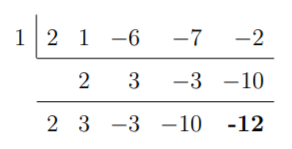
Here, we see that +1 gives a remainder of –12. Thus, it is not a root of f(x). Let us try, –1.
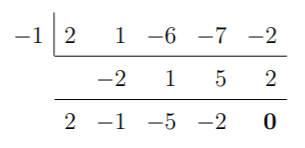
In this case, –1 gives a remainder of 0. Thus, –1 is a solution to f. The result of this synthetic division also tells us that we can factorize f as:
Step 3: Next, repeat this process on the quotient:
Using the Rational Zeros Theorem, the possible, the possible rational zeros of this quotient are:
As we have shown that +1 is not a solution to f, we do not need to test it again. However, we must apply synthetic division again to –1 for this quotient. This will show whether there are any multiplicities of a given root.
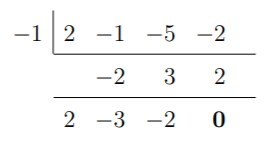
Again, we see that –1 gives a remainder of 0 and so is a root of the quotient. This shows that the root –1 has a multiplicity of 2. Hence, f further factorizes as
Step 4: We thus end up with the quotient:
which is indeed a quadratic equation that we can factorize as:
This shows that the remaining solutions are:
The fully factorized expression for f(x) is thus,
Setting f(x) = 0 and solving this tells us that the roots of f are,
Determine all rational zeros of the polynomial
.
Step 1: Using the Rational Zeros Theorem, we shall list down all possible rational zeros of the form .
Here, p must be a factor of and q must be a factor of .
Thus, the possible rational zeros of f are:
Step 2: We shall now apply synthetic division as before. We shall begin with +1.
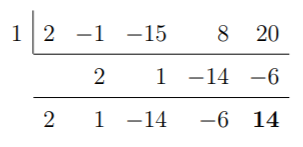
Here, we see that +1 gives a remainder of –14. Thus, it is not a root of f. Let us try, –1.
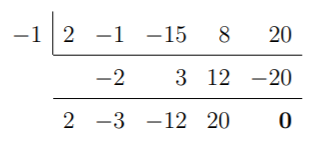
In this case, –1 gives a remainder of 0. Thus, –1 is a solution to f. The result of this synthetic division also tells us that we can factorize f as:
Step 3: Now, repeat this process on the quotient
By the Rational Zeros Theorem, the possible rational zeros of this quotient are:
Since +1 is not a solution to f, we do not need to test it again. However, we must apply synthetic division again to –1 for this quotient.
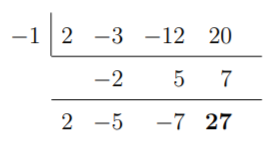
Here, we see that –1 gives a remainder of 27. Thus, it is not a root of the quotient. In other words, there are no multiplicities of the root –1. Let us now try +2.
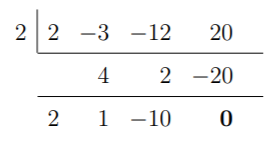
In this case, +2 gives a remainder of 0. Thus, +2 is a solution to f. Hence, f further factorizes as:
Step 4: Observe that we have the quotient
which is indeed a quadratic equation that we can factorize as:
This shows that the remaining solutions are:
The fully factorized expression for f(x) is thus,
Simplifying this, we have
Notice that the root 2 has a multiplicity of 2. Setting f(x) = 0 and solving this tells us that the roots of f are:
Geometry and the Rational Zeros Theorem
In this section, we shall look at an example where we can apply the Rational Zeros Theorem to a geometry context.
Amy needs a box of volume 24 cm3 to keep her marble collection. She knows that she will need a box with the following features: the width is 2 centimetres more than the height, and the length is 3 centimetres less than the height. From these characteristics, Amy wants to find out the true dimensions of this solid. How would she go about this problem?
Before we begin, let us recall Descartes’ Rule of Signs.
Descartes’ Rule of Signs
Let p be a polynomial with real coefficients.
- The number of positive real zeros of p is either equal to the number of variations in sign in p(x) or is less than that by an even whole number.
- The number of negative real zeros of p is either equal to the number of variations in sign in p(–x) or is less than that by an even whole number.
Let us now return to our example. The solution is explained below.
Step 1: Assign Variables
Let the unknown dimensions of the above solid be
Sketching this, we observe that the three-dimensional block Annie needs should look like the diagram below.
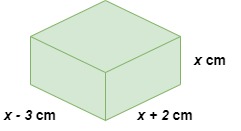
Geometrical example, Aishah Amri - StudySmarter Originals
Writing down the equation for the volume and substituting the unknown dimensions above, we obtain
Expanding this and bringing 24 to the left-hand side, we obtain
Step 2: Apply Rational Zeros Theorem
Here, the leading coefficient is 1 and the coefficient of the constant terms is 24. By the Rational Zeros Theorem, the possible rational zeros are factors of 24:
Since the length can only be positive, we will only consider the positive zeros, Noting the first case of Descartes' Rule of Signs, there is only one possible real zero. This is because there is only one variation in the '+' sign in the polynomial
Step 3: Conduct Synthetic Division
Using synthetic division, we must now check each of the zeros listed above. For simplicity, we make a table to express the synthetic division to test possible real zeros. The row on top represents the coefficients of the polynomial
and the column on the farthest left represents the roots tested. The column in the farthest right displays the remainder of the conducted synthetic division.
| p | 1 | -1 | -6 | -24 |
| 1 | 1 | 0 | -6 | -30 |
| 2 | 1 | 1 | -4 | -32 |
| 3 | 1 | 2 | 0 | -24 |
| 4 | 1 | 3 | 6 | 0 |
From this table, we find that 4 gives a remainder of 0. Thus, 4 is a solution to the polynomial
As we have established that there is only one positive real zero, we do not have to check the other numbers.
Step 4: Evaluate Dimensions and Confirm Results
Thus, the true dimensions are
To verify this, we observe that
which is indeed the initial volume of the rectangular solid.
Finding Rational Zeros - Key takeaways
- A rational zero is a rational number written as a fraction of two integers.
- The Rational Zeros Theorem states that if a polynomial, f(x) has integer coefficients, then every rational zero of f(x) = 0 can be written in the form .
- The Rational Zeros Theorem only tells us all possible rational zeros of a given polynomial.
- Identifying the zeros of a polynomial can help us factorize and solve a given polynomial.
- There are 4 steps in finding the solutions of a given polynomial:
- List down all possible zeros using the Rational Zeros Theorem.
- Apply synthetic division to calculate the polynomial at each value of rational zeros found in Step 1.
- Repeat Step 1 and Step 2 for the quotient obtained. Stop when you have reached a quotient that is quadratic (polynomial of degree 2) or can be easily factored.
- Set all factors equal to zero and solve the polynomial.















